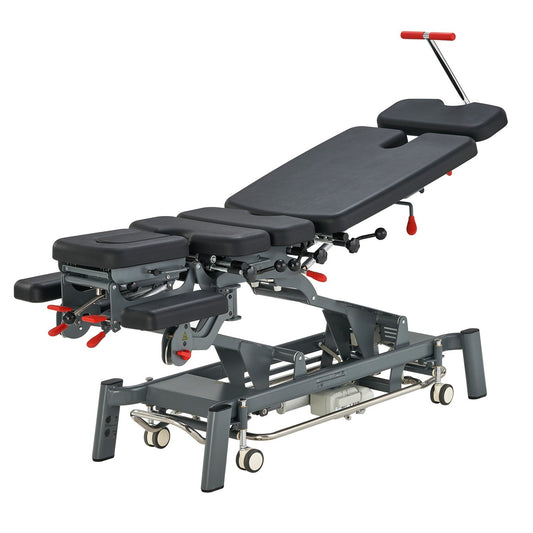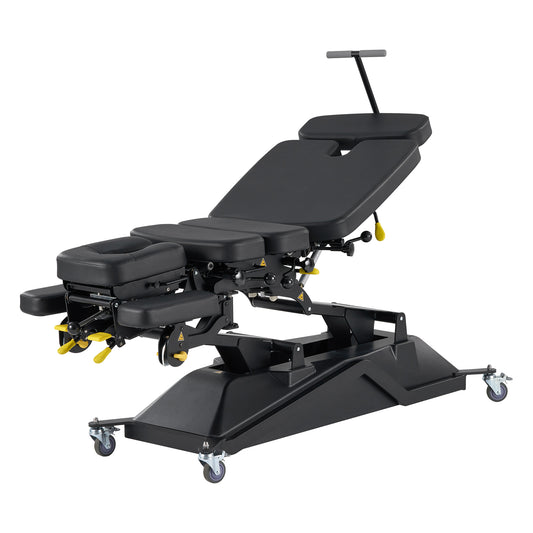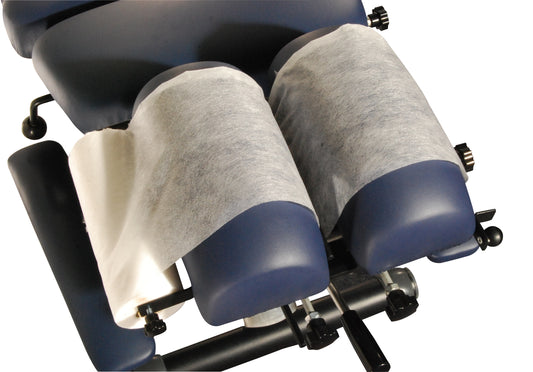Types of Chiropractic Tables
Chiropractic tables offer different experiences to the patient and to the chiropractor. Here’s a rundown on different types of chiropractic tables to consider.
1. Stationary Chiropractic Tables
Stationary chiropractic tables are the backbone of many clinics, offering a stable, reliable surface for daily spinal adjustments. These tables typically feature adjustable headpieces, drop sections, and firm foam cushions for precision and comfort.
Iron-280 features cervical, thoracic, and pelvic drops with firm foam cushions — ideal for consistent, everyday clinic use.
2. Portable Chiropractic Tables
Portable tables deliver the flexibility to take chiropractic care beyond the clinic — to events, sports teams, and home visits. They share many core features with stationary models, including adjustable headrests and drop sections, but are lightweight, foldable, and easy to transport.
MT Chiropractic’s Arena-180 perfectly embodies this design: a foldable aluminum-frame table with dual drop zones, adjustable height, and a convenient carrying case. Ideal for mobile practitioners who value both function and mobility.
3. Elevation Chiropractic Tables
Elevation tables use electric lift systems to adjust table height, improving ergonomics for chiropractors and accessibility for patients. These tables reduce strain during extended sessions and provide precise positioning for manual adjustments.
Absolute™ uses dual synchronized motors and a single-column PowerLift for smooth, silent height control.
4. High-Low Chiropractic Tables
High-low tables combine height lift with a full tilting mechanism, transitioning smoothly from a horizontal to an inclined position. This feature supports patients with limited mobility or postural needs while maintaining optimal therapist access.
Absolute™ tilts up to 52°, allowing patients to step on comfortably — perfect for rehabilitation and mobility support.
5. Flexion-Distraction Chiropractic Tables
Flexion-distraction tables are designed for controlled spinal decompression through rhythmic, multi-axis movement. Chiropractors use them to relieve disc pressure, improve mobility, and reduce lower back tension.
Absolute™, Prime™, Herrington™, and Fairworth™ provide controlled 3D flexion, lateral motion, and manual traction.
6. Traction Chiropractic Tables
Traction tables use sustained or intermittent traction to stretch the spine and reduce nerve compression.
They help treat herniated discs, sciatica, and chronic back pain through controlled traction force and patient positioning.
The Absolute™, Prime™, Herrington™, and Fairworth™ tables include manual lumbar traction systems with built-in guide rails, providing smooth traction force and excellent control for decompression therapy.
7. Decompression Chiropractic Tables
Decompression tables specialize in non-surgical spinal decompression therapy, using gentle traction to promote healing of disc-related conditions and improve spinal alignment.
Absolute™ and Prime™ combine traction control with ergonomic comfort for precise therapy.
8. Smart Chiropractic Tables (Under Development)
Smart chiropractic tables represent the future of spinal care — integrating sensors, AI-driven motion control, and automated adjustment systems for personalized therapy.
MT Chiropractic’s upcoming Smart Series is in active R&D, designed to analyze patient posture, pressure distribution, and feedback in real-time to deliver truly adaptive, data-driven chiropractic treatment.
-
Fairworth-381 Chiropractic Table – Heavy-Duty Drop & Flexion Distraction Therapy Bench MT Chiropractic™
Regular price $3,990.00Regular price -
MT Chiropractic™ Absolute-300 3D Flexion Distraction Chiropractic Table-for Spine Osteopathy Treatment
Regular price $10,900.00Regular price -
MT Chiropractic™ Arena-180 Aluminum Portable Chiropractic Adjustment Table – Lightweight yet Stable
Regular price $599.00Regular price -
MT Chiropractic™ Herrington-480 Drop Chiropractic Flexion Distraction Manipulation Table
Regular price $3,690.00Regular price -
MT Chiropractic™ Iron-280 Stationary Chiropractic Adjustment Benches – Manual Drop & Break-Away Section
Regular price $2,399.00Regular price -
MT Chiropractic™ Prime-400 Chiropractic Table – Manual Drop & Flexion-Distraction Spine Treatment
Regular price $8,900.00Regular price













